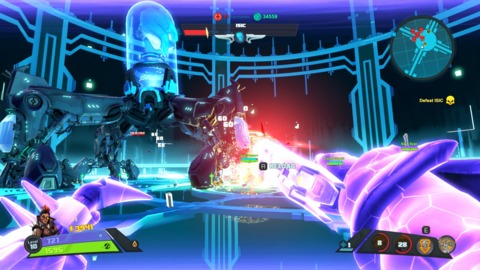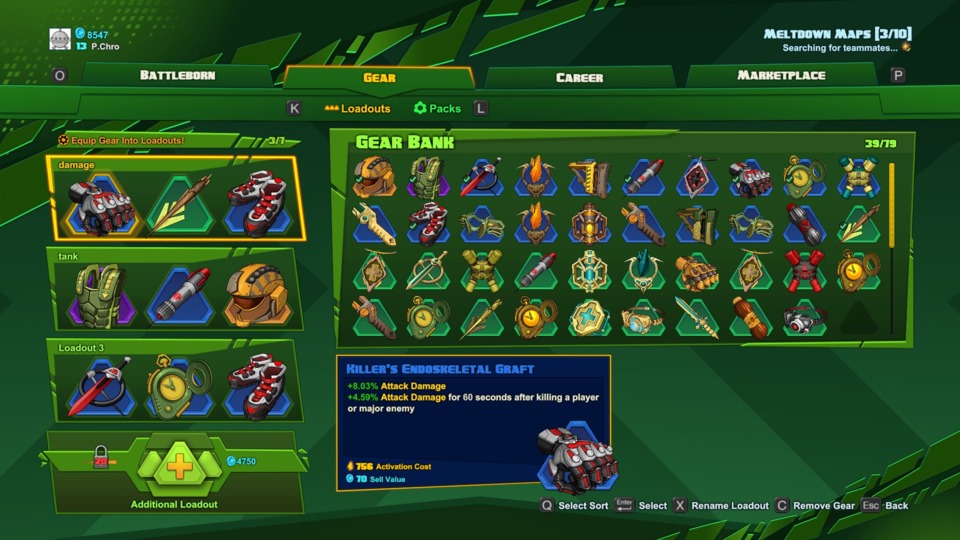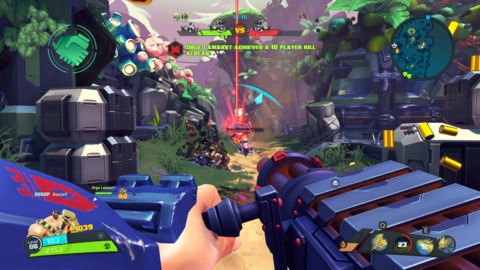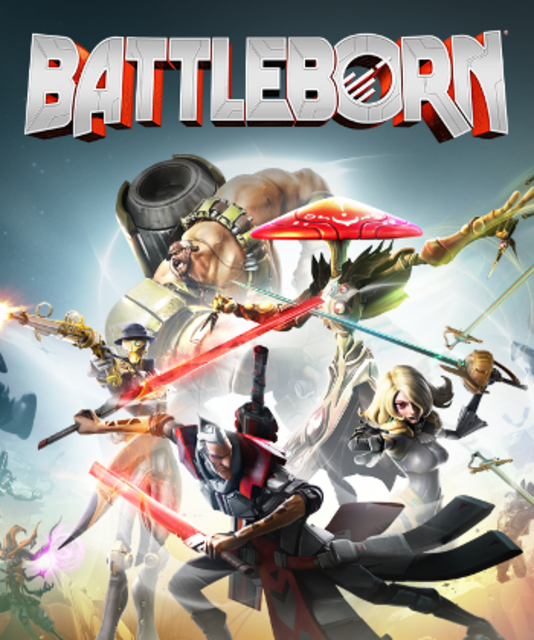Part-Time Gamers Review: Battleborn
I’ve had fun playing Multiplayer Online Battle Arena games--MOBAs for short--like DOTA 2 and League of Legends for more than a decade. I also really enjoyed the Borderlands games that I’ve managed to play. Hearing that the Borderlands team were making a game in the style I love sounded like everything I could ask for. Unfortunately, Battleborn fails to keep its focus on what makes a good MOBA, and spreads itself thin with other content too.
The introduction to the world tells a tale of the universe going to darkness until there is only a single star left. All the civilizations that could get to that star did, and war broke out among them, as well as the Verelsi--the dark force around which the story mode revolves. Through all this fighting, heroes rise up and will be brought together to become the “Battleborn.” After hearing the same bad jokes every time you use one of your abilities, you will notice there are only two personality types a battleborn can be; the class clown and the badass class clown.
The game is an always-connected multiplayer game, first and foremost a competitive one, as indicated by the fact that the first selection on the main screen is the Versus Public option. From the start there are only seven heroes available for selection out of twenty-five total, and the character used for the tutorial is not among them. The game is also full of progression systems for each individual hero as well as for your overall account. By leveling up an individual character you can unlock more ability modification choices for that hero to select during a match. The account level progression will unlock more characters, although very slowly. After about 20 hours of play I was account level 13 and the last character unlocks at level 40. This means the fastest way to unlock most of the characters is through the story mode.
The story mode consists of eight cooperative missions, seven of which must be completed to do the finale. When you decide to play the story mode, Battleborn will begin searching for a team of other players for about five minutes, or less, if it finds four other people before that. If it does not find anyone else, it will just load you up as a single-player mission. Since it is possible for the game to load you into missions solo, I found it quite annoying that it would force me to wait the five minutes rather than give me the option to start alone right away. However, not finding other people can be more annoying since one of the characters unlocks by completing five co-op missions with at least one other player.
Once a team is found or the waiting time is over, three of the seven missions are randomly selected for the team to vote on which to play. Another particularly annoying occurrence happens once you have only one mission left to unlock the finale. If that mission does not random into the three options or the other players out vote you for one of the other missions, you are stuck playing through one you’ve already done again or you are that jerk who left the game. Luckily, the final mission has a separate queue for searching so you can at least guarantee attempting that one once you unlock it.

When it finally loads in, you get a short explanation about the mission, select characters from those you’ve already unlocked, and begin the mission. Each mission plays out with your team having a limited number of shared respawns to complete it, and they tend to take about 35 minutes. Just like in the competitive matches, your heroes start at level 1 and level up throughout the missions. Each of these level ups allows you to select modifications to your abilities and test them out in a less stressful environment than the competitive mode offers. A few of the story missions also have interesting bosses which mechanically resemble encounters closer to something out of a World of Warcraft raid, rather than the boring bullet sponges that the other half of the bosses boil down to. Unfortunately a few of the story missions contain some extremely poor design choices. For example, in one mission you must defend some towers from waves of enemies during the first 5 minutes of the mission, only to return to that zone to defend the same towers during the finale. The towers do not regenerate their defenses, which means if things go a bit wrong at the start and they are severely damaged, the finale becomes almost unbeatable. One enemy breaking through and hitting the towers will finish them off and fail the mission. Oh yeah, if a mission fails, that is it, no checkpoints, just back to the main menu to queue again and hope you can start the 35-minute mission over again from the start.
The competitive mode is divided into three game types: Capture, Incursion, and Meltdown. Each of these has a different set of rules and two unique maps to play on. Each of these modes also has separate queues for matchmaking. Though the wait time always said “short,” more than once I waited over 10 minutes to find a match. I can’t help but imagine that the queues would be significantly shorter for all modes if there was a way to search for any game type, instead of locking into a search for one at a time.
In Meltdown there are two paths of AI controlled units marching towards the enemy base. If they reach a point just past the middle without dying they are scored for points towards the 500 needed to win. When the team is halfway to winning, the path the AI units travel extends towards to the enemy base. This makes them require more protection before they can be scored. This mode was ok, but the focus on protecting your units pulls the action away from more interesting skirmishes. In Capture there are three zones of control, each of which gives your team points while they are held. First team to 1000 points wins. I found this mode to be the most fun, in part because the lack of AI units running around allowed for a lot more clarity during the team fights. However because friendly hitboxes block shots, despite no friendly fire, there are many cases where you really cannot do a lot to help your team. One big example of this problem comes with the hero Montana, who is about two-and-a-half times larger than anyone else. While he is one of the tanky characters and harder to kill, he also ends up being a shield for the enemies whenever he is at the frontline of the fighting, until he dies.
The real meat of Battleborn is in the Incursion mode, which makes sense since it is the most similar to other MOBA games. In it, each team has AI units marching towards the enemy defenses down a single path. Pushing your minions forward to reach the enemy defenses and lay siege to them will deplete enemy base’s life bar. Despite the problems I have with the size of the AI units--friendly or not--there was one thing that drove me up a wall more than any other. This mode has a hard stop to the match at the 30 minute mark. On its face, this does not sound like that bad of an idea; the fact that matches in DOTA 2 or League of Legends can go for over an hour can be an issue for the more casual player. Still, I never had a single match finish with a full depletion of the base’s health bar for either team. It was always a win or loss based on who had more base health left at the buzzer. A big part of what makes the competitive nature of MOBAs--and fighting games or really any competitive game--is the ability to mount a last ditch effort or major play that swings the game the other way for an amazing comeback. It is thrilling to be on or even watch a team pull out a victory from what seems like an insurmountable deficit. This hard limit on the length of matches really discourages and prevents comebacks from happening. This has made the bane of every MOBA--the leaver--even more common place in this one. And can you really blame them for leaving? There is no good reason to spend 10 more minutes in a game you have been steadily losing, even if your team just won a big fight and finally swung the momentum in their favor. It took the winning team 20 minutes to get this far, and you don’t have 20 minutes left to bring it back no matter how well you keep them off their feet. You can spend that 10 minutes finding a new match instead of wasting time in this one.

None of this is really bad enough to completely write off Battleborn. Unfortunately, there are many more details that detract from the experience. I mentioned the characters all have the same personalities, which is boring. What is worse, there are some wildly varied strengths among the abilities of characters. One example being the hero Ghalt, the last hero to unlock via account level. He wields shotguns that are strong at close range, can lay an invisible trap that will stun enemies for a few seconds, has a hook that can pull enemies to him and his trap, and can double his rate of fire as his ultimate. When you compare that to someone like Orendi, who is unlocked at the start, you find that there is a lot more synergy between the abilities for the unlockable characters. Orendi’s kit allows her to deal a burst of damage close in front of her which propels her away, summon a vertical pillar that deals damage to enemies in it, and for her ultimate, can summon that pillar horizontally for a long range nuke. This isn’t to say she isn’t effective at doing her job, dealing lots of damage to lots of people, but her abilities don’t chain together into some kind of combo the way Ghalt’s do. Seeing this kind of disparity in characters is problematic, and is exacerbated with the way matchmaking seems to work.
I mentioned waiting upwards of 10 minutes to find a match, but the matchmaking has issues beyond the wait time. When you queue it would first find other players for your team. I believe the biggest gap in account level I saw among my team was about 15 levels. Once a team is found it then searches for a team to play against, and it appears to be much less strict with who that is. The enemy team would still be within around 15 levels of each other, but I often found myself playing against teams with account levels in 80s. It is no surprise then to find that those teams often were using heroes I was still trying to unlock, and frankly heroes with more interesting and stronger ability kits.
Then you run into the actual level designs, which seem to be built too tightly together without much room for sneaking around enemies. This makes the melee assassin heroes—who deal lots of damage but are not good at survival--feel like they are at a distinct disadvantage as it is very hard to find a way to close the gap without long lines of sight for the enemies to spot you. On top of that, I found sections on all the maps where I would get stuck on the terrain despite knowing full well it was a traversable path. First-person shooters require a lot of fast movement, so getting stuck on something isn’t just detrimental, but frustrating. Then there is the gear system, which I honestly didn’t realize existed for the first eight hours or so. The currency collected in matches to upgrade defense turrets can also be used to purchase gear you’ve selected prior to the match, which can modify stats like attack speed or shield recharge rate. This gear is selected with a loadout in the “Command” selection off the main menu. This gear, as far as I could tell, was only found in the story mode from random drops or by purchasing loot packs with in game credits earned by playing matches. Note that these credits are not the same as the currency you are collecting inside of a match while actually playing the game. The entire gear system gives such minor passive boosts that it doesn’t feel like it is worth engaging in and doesn’t bring anything meaningful to the matches. Even if they effects were meaningful and you ran into a player who seemed like they were doing really well, there is no way to inspect them and see what gear they are using to pull that off, and no outward graphical changes to indicate them either.

After all of this, the biggest thing holding back the competitive mode is actually the first-person perspective. This was a bit of a surprise to me as I came to realize why it was such an issue. The MOBA genre has traditionally spawned from real-time-strategy games with an eye-in-the-sky perspective over the battlefield. Being able to see everything in this way allows you to make moment-to-moment decisions with clear information. There are some abilities in this game with graphical effects that are huge and frankly blinding, if they are right in front of or completely surrounding you. Funny enough, those skills do not actually inflict the “blind” condition which IS a part of this game. When you have the eye-in-the-sky perspective, a melee enemy might jump in behind you to try and get a kill. You can see who it is and judge how to react. What makes the first-person perspective so bad is that you get a flashing indicator on the screen letting you know what direction you were damaged from, but no good information about what damaged you. You can glance at the map, but with more than one enemy on it, was it that enemy on the map farther behind you with a gun or that enemy in front of you casting a spell behind you that you can’t see? You cannot tell until you turn around, and in the case that it was a melee character, you might have gotten away by using a long refresh time ability immediately instead of running for cover while checking the map. These decisions are really hard to make in the moment without clear information. Super Monday Night Combat from 2012 also tried to mix shooters with MOBAs, but did it from a third-person perspective where you could always see your back and if someone was on it. While that game had its own issues, clarity of information was never one of them.
Battleborn is not a good game, which is really disappointing, since I wanted so badly to like it. It is a game riddled with poor design choices, boring and unbalanced characters, and too many systems that lock away content or fail to add meaningful value. If you wanted a fulfilling co-op story experience, go back and play the Borderlands games. Maybe you want a class based competitive shooter, but Overwatch and Team Fortress 2 do it better. Perhaps you were wanting to try out a MOBA, however DOTA 2 and League of Legends have been doing it better for years. And hell, if you were really hoping for a Shooter mixed with MOBAs, Super Monday Night Combat isn’t the only one that did it before.
